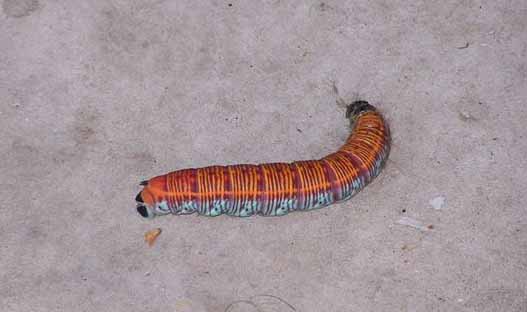
Pachylia ficus, McAllen, Texas, courtesy of Laura Elaine Moore via Greg Lasley.

Pachylia ficus, McAllen, Texas, courtesy of Laura Elaine Moore via Greg Lasley.
Laura writes, September 26, 2005, "I'm the one who took the photo of the Fig Sphinx caterpillar in McAllen, Texas, that Greg Lasley got you to ID for us. Feel free to use the image on your website with the credit: Laura Elaine Moore. I snapped these photos a couple of years ago or so. I have the date at home. Let me know if you'd like to have it. I may also have shots from a couple of different angles, I'd have to check. Just let me know."
Special thanks also goes to Mike Quinn who provides many sightings and images from extreme southern Texas. Mike has provided the two larval images below from Cameron County and Hidalgo County.
Joshua S. Rose reports the following species from Hidalgo County:
Ceratomia undulosa;
Manduca rustica;
Manduca sexta (larva as well as adult);
Sphinx libocedrus;
Aellopos sp. (several poor in-flight photos);
Enyo lugubris;
Erinnyis ello (larva as well as adult);
Erinnyis obscura;
Pachylia ficus (larva as well as adult);
Eumorpha satellita;
Eumorpha vitis (larva as well as adult);
Hyles lineata (larva as well as adult);
Xylophanes tersa (larva as well as adult).
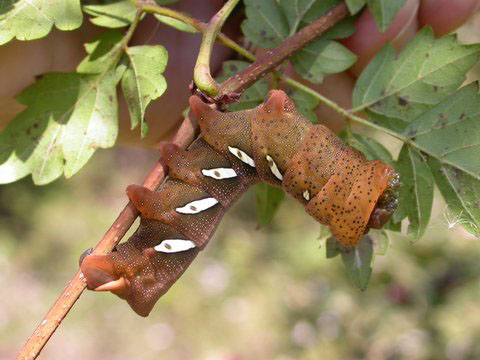
Eumorpha satellitia licaon, October 20, 2005,
Sabal Palm Audubon Center & Sanctuary
Brownsville, Cameron Co., courtesy of Mike Quinn.
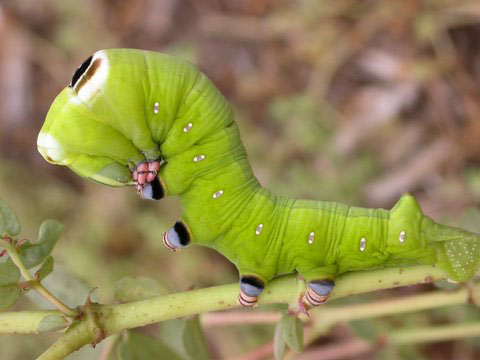
Erinnyis ello, October 24, 2005,
Bentsen-RGV State Park, Mission, Hidalgo County, courtesy of Mike Quinn.
A "USGS" indicates the moth is reported on the USGS website and/or in Lepidoptera of North America, #1. Distribution of Silkmoths (Saturniidae) and Hawkmoths (Sphingidae) of Eastern North America, an excellent little booklet available through Paul Opler.
Please help me develop this list with improved, documented accuracy by sending sightings (species, date, location), preferably with an electronic image, via email to Bill Oehlke.
The night-blooming moon flower will attract many Sphingidae at dusk and into the night.
Sphinginae subfamily
Manduca rustica, Mission (Hidalgo County), Texas,
October 1, 2009, courtesy of Gus A. Rentfro. Manduca sexta, Hidalgo County, Joshua S. Rose
Macroglossinae subfamilyDilophonotini tribe:
Erinnyis ello, Hidalgo County, Joshua S. Rose
Philampelini tribe:
Eumorpha vitis, Mission (Hidalgo County), Texas,
Macroglossini tribe:
Adult moth observed outdoors, December 24, 2005; Cat Traylor, Hidalgo
|
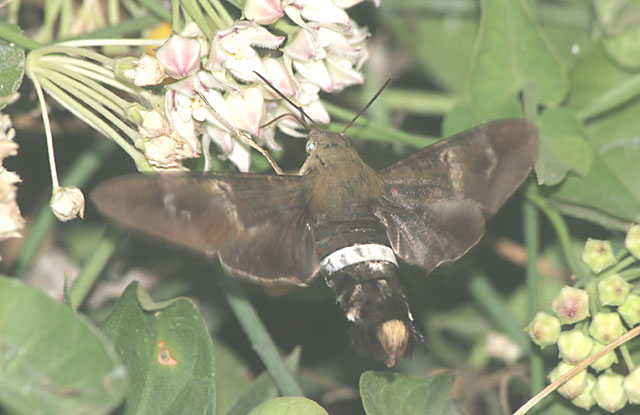
Aellopos clavipes, Hidalgo County, Texas, August 28, 2006, courtesy of Gil Quintanilla
From Southern Texas, Cat Traylor reports, this one "was chowing down on my yellow morning glories (Ipomoea ochracea)."
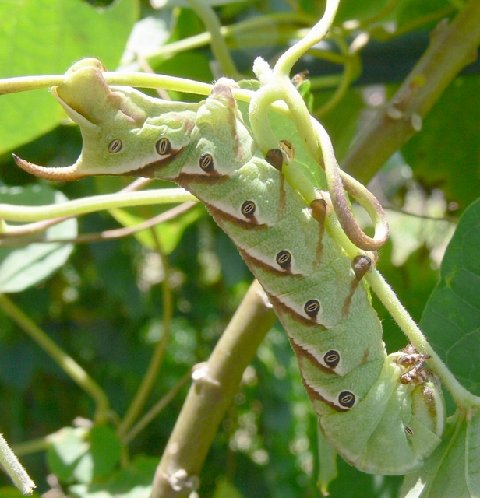
Agrius cingulata on Ipomoea ochracea, courtesy of Cat Traylor.
Bill Dempwolf reports the following from South Padre Island near the tropical tip of southeastern Texas: Agrius cingulata, Manduca sexta, Manduca quinquemaculatus, Manduca rustica, Pseudosphinx tetrio, Erinnyis ello, Erinnyis obscura, Aellopos clavipes, Aellopos titan, Eumorpha vitis, Xylophanes tersa and Hyles lineata.
Enjoy some of nature's wonderments, giant silk moth cocoons. These cocoons are for sale winter and fall. Beautiful Saturniidae moths will emerge the following spring and summer. Read Actias luna rearing article. Additional online help available.
Eggs of many North American species are offered during the spring and summer. Occasionally summer Actias luna and summer Antheraea polyphemus cocoons are available. Shipping to US destinations is done from with in the US.
Use your browser "Back" button to return to the previous page.
This page is brought to you by Bill Oehlke and the WLSS. Pages are on space rented from Bizland. If you would like to become a "Patron of the Sphingidae Site", contact Bill.
Please send sightings/images to Bill. I will do my best to respond to requests for identification help.
 Show appreciation for this site by clicking on flashing butterfly to the left. The link will take you to a page with links to many insect sites. |
I very much appreciate all the many images that have been sent to me, or of which I have been granted permission to copy and post from other websites. All images on this site remain the property of respective photographers.
If you would like to contribute to the maintenace of this website by sending a contribution to
Bill Oehlke
Box 476
155 Peardon Road
Montague, Prince Edward Island, C0A1R0
Canada
your donation would be much appreciated and would be used for
1) paying for webspace rental;
2) paying for computer maintenance and software upgrades;
3) purchases of additional text reference material (journals and books) in anticipation of expanding the site to a worldwide Sphingidae site;
4) helping to pay my daughter's tuition; with anything left over going to humanitarian aid.
If you are mailing a check from USA, please use $0.85 postage. Donations can also be made through Paypal via the button below.